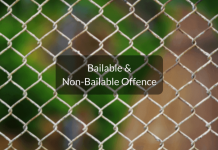This article has been written by M.R Lance Kewin, a student of Symbiosis Law School, Nagpur, Maharashtra.
Abstract
The following article is an overview of the topic “criminal law” where it is explained about the purpose of criminal law, types of criminal law and the features of criminal law and followed by advantages and disadvantages of criminal law. Crime is increasing venomously in and around the world at a fast rate. These bylaws are being passed in order to keep society from crime-free activities committed by criminal offenders. It is due to this reason bylaws under criminal laws are being enacted around the globe to keep a check in the crime rates and make possible efforts to reduce the crime rates in order to leave a healthy society.
Keywords
The following words mentioned below are considered as the most important words used in a paragraph or to deliver an important statement.
1)IPC (Indian penal code)
2)perpetrator (person who carries out a harmful Act)
3)Misdemeanours (a minor doing a wrongful act)
4)felonies (crime committed which is considered as more dangerous than a misdemeanor)
5)criminal offenders (person who is convicted for a commitment of crime)
6)plea bargain (agreement between prosecutor and defendant)
7)punishment (rough treatment)
8)Cr.P.C (code of civil procedure)
9)imposition (tax applied or duty)
Introduction
The following article is based upon an in-depth study of the legal aspect ‘’Criminal Law”. This article is based upon the origin, the workings, the methodologies followed, the purpose and the use /presence of criminal law. In the following article, we would be viewing about the basics of criminal law, the pros and cons of criminal law, its main agenda of the existence in the society, the purpose of criminal law etc. Criminal Law has a crucial and prominent role in society. The law is present to resolve disputes between citizens. It provides a peaceful way to handle situations. Protecting citizens and property. Criminal law protects citizens from criminals who would bring about physical harm to others or in society. Criminal law gives rise to government officials to collect taxes, control pollution, and accomplish other necessary needs.
Context
The criminal law is defined as a body of law which deals with judgements regarding the wrongful act and other offences and is also responsible for charging and giving a trial to the convicted offenders.
The basic function of criminal law is to give justice to the offender and punish the guilty by legal actions.
In today’s Modern world, Crime is being held in many areas around the world. For example, theft, murder, physical abuse, sexual abuse, emotional abuse, threatening etc. In order to eradicate these wrongful acts by the wrongdoer, criminal law is framed. In India, IPC (Indian Penal Code) is formed. The Indian penal code is the at present criminal code of India. It is a comprehensive method initiated to cover all aspects of criminal law. The Indian penal code was enacted on 9th October 1860. There are various sections placed with separate punishments framed.
For example, Section 405 is known for “Breach of Trust”
Section 304 is known for “Culpable Homicide”
The main thesis for criminal law includes: to eradicate crime, to improve the perpetrator, to provide necessary punishment for the act, and to prevent further crimes. There are two types of criminal laws: misdemeanours and felonies (2).
A misdemeanour is considered as a lower-level criminal offence such as minor assaults, traffic rules violation.
Usually, in many parts of a country, the punishment for these kinds of offences lasts mostly a year or two in the period.
Whereas, A felony is considered as a higher-level criminal offence such as murder, rape, robbery.
Punishments for these types of offences in India are either life imprisonment or the death penalty.
The most important aspect of criminal law is the elements of criminal law.
There are about 7 elements regarding criminal law. They are:
1)Legality–(Accordance with the law)
2)Actus Reus— (Conduct of Crime)
3)Causation— (Action of something)
4)Harm— (Physical or Material damage)
5)Concurrence— (Events of two or more events at the same time)
6)Mens Rea— (Intention of a wrongful act in a part of crime)
7)Punishment–(Imposition of penalty as payback towards an offence).
These constitute the 7 Main Elements of Criminal Law.
Each of the element has its own brief of description. The agenda of criminal law is that the purpose of outlawing conduct is to protect society. Law Makers pass a law with the belief of developing public good. The Act of Criminal Law is to be applied evenly in society. The purpose of punishing criminal offenders includes retribution, behavioural activities and preventing further offences and behavioural activities by the offender.
In India, crime rates increase each and every year. There can’t be a full stop to all the crime rates but with certain disciplinary rules and regulations, we can prevent further criminal activities by eliminating a particular criminal offence. The punishments are meant to reduce the crime rates and it has shown significant changes in society. In Today’s Society, each and every citizen knows the fact of what a good thing is and what a bad thing is but there are some people known as lawbreakers who are well aware of the punishments but yet commit a crime and pay the price for the commitment.
Analysis
The Law Makers have formed Laws which is equally applied to each and every citizen in the society. Particular law is not framed in accordance with a particular person. It is drafted accordingly which is evenly correlative to every citizen. In the United States, all levels of government commit the crime. The federal government, state government and even the local authorities are said to commit some small criminal activity. And the committed crimes come under the respective courts i.e. If a person is implicated with a federal crime, he is answerable under federal court. If a person is implicated under the local unit, the paperwork of the case should be filed in the appropriate court and their own attorney is subjected to be present for the execution of the offence.
The Important point to be noted regarding the local government is that a smaller unit of government cannot invalidate a higher unit’s law. E.g. If a state government makes it illegal to possess drugs, a city government cannot invalidate with that law or they can’t nullify that law.
There are various stages present in a criminal case.
A criminal case begins with the paperwork of filing the arrest warrant. The charges on the offender are based on the decisions of the attorney. But the police are subjected to make an initial arrest. Then the case is subjected to the first semblance in the court. A magistrate reads the case in a formal way. Then the conditions of a bond are set. In some serious cases, the court may order law enforcement to hold up the person without any bond until the final statements of the case.
Hypothesis
Criminal Procedure in the United States
Criminal systems at the federal, state and local levels must follow a series of rules governing the stages of a criminal case, beginning with police investigations and continuing all the way through trial and appeal. The federal procedure is governed by substantive criminal laws found in Title 18 of the U.S. Code and the Federal Rules of Criminal Procedure. Every state has its own code of criminal statutes. Necessary rules help to ensure that the government applies the law as possible, and also help safeguard individuals’ rights. These procedures apply in all criminal matters, as well as in some quasi-criminal proceedings, such as removal of verdicts.
Case study (From West Law)
Campbell (Aaron) vs HM advocate
High Court of Justiciary (Appeal)
[2019] HCJAC 58; [2019] 9 WLUK 56; 2019 G.W.D. 28-457;
Subject: Sentencing
Keywords: Abduction; Appeals; Child offenders; Murder; Rape; Scotland; Sentence length; Sentencing
Summary
An appeal by a male, aged 16 at the relevant time, against the imposition of a sentence of detention without limit with a punishment part of 27 years for the abduction, murder and rape of a six-year-old girl, would be allowed where the trial judge had led the trial judge to make inadequate allowance for the mitigatory effect of youth and a punishment part of 24 years would be substituted.
Abstract
A male, convicted by unanimous verdict of the abduction, murder and vaginal and anal rape of a six-year-old girl, when he was 16 years old, appealed against the imposition of a sentence of detention without limit with a punishment part of 27 years on the basis that it was excessive.
It was submitted that while the crime was an uncommonly grave one which, for an adult, would have attracted a substantial punishment part, the trial judge had placed undue weight on the pessimistic assessment of his ability to change; such an assessment was more a question of future risk rather than aggravation to be reflected in the punishment part.
Code of Civil Procedure (CRPC)—(India)
The Code of Criminal Procedure (CrPC) is the main period on the procedure for administration of criminal law in India. It came into force on 1 April 1974. It provides the power for the investigation of criminal activity, the intention of suspected criminals, collection of evidence, determination of guilt or innocence of the accused person and the determination of punishment of the guilty. It also deals with public nuisance, prevention of offences and maintenance of family members.
Case Study (From West Law)
Guruviah and another v State, represented by Inspector of Police
Supreme Court of India
Criminal Appeal No(s). 1208 of 2019 (Arising out of S. L. P. (Crl.) No. 1658 of 2019) with Criminal Appeal No(s). 1209 of 2019 (Arising out of S. L. P. (Crl.) No. 3985 of 2019)
Summary
- The appellants, who are village assistants, challenge their conviction under Sections 13(1)(d), 13(2) and 12 of the Prevention of Corruption Act, 1988 (hereinafter called as “the Act”) with fine and a default stipulation sentencing them to one year of rigorous imprisonment. The appellants have been acquitted of the charge under Section 7 of the Act and Section 109 of the Indian Penal Code. The village administrative officer, accused no.1, was convicted under Sections 7, 13(1)(d), 13(2) and 12 of the Act. He has since been deceased during the pendency of his separate appeal.
- The appellants were village assistants in the office of the village administrative officer, arrayed as accused 2 and 3. On 17.12.2003, P.W. 2 lodged a written complaint before the Additional Superintendent of Police (Vigilance and Anti-Corruption) that the village administrative officer had demanded a sum of Rs. 600/- for signing the necessary papers to facilitate the transfer of electric connection in the name of the complainant. The illegal gratification is stated to have been handed over to one of the appellants on the instruction of the village administrative officer, and who after counting it handed it over to the other appellant. They were apprehended by the trap officials immediately thereafter and the money recovered.
Some Common Criminal Procedures
When a defendant goes on trial for allegedly committing a crime, an undertaking must establish that the defendant is guilty of the crime beyond a reasonable doubt. At the same time, the defendant is authorized to present a defence and may do so through different means. The defendant may attempt to find loopholes in the prosecutor’s case, argue that another individual who committed the crime, or argue that he \ she did commit the crime but had a legal defence for said commitment. There are various criminal defences are present which may allow a defendant to avoid punishment for his or her actions.
Meaning of Bail and Bond
Once a person is in police custody and is charged with an alleged offence, He /She may be able to get out of jail by posting bail or obtaining a bond. A judge regulates the amount of bail based on factors like the seriousness of the alleged offence, the probability that the defendant will commit supplemented crimes after being set free, and the chances that the defendant will flee the jurisdiction before trial. A judge may set bail at any amount which is not questioned or deny bail altogether. The Eighth Amendment to the U.S. Constitution prohibits “Excessive Bail” but does not state that the said conditions are required to allow bail.
Differences between Bail and Bond
The words ‘Bail ‘and ‘Bond’ are often used almost use to alternate facts when discussing jail release, and while they are closely related to each other, they are not the same thing. Bail is the money where a respondent must pay in order to get out of jail. A bond is posted on a respondent’s behalf, usually by a bail bond company, to secure his /her release.
Plea Bargain
Majority of criminal sentence result from plea bargains. Their prevalence has arisen as a matter of necessity for many prosecutors and judges since the criminal justice system has become overload and incompetent. In a plea bargain, the defendant and the prosecutor reach an agreement in which the defendant pleads guilty or no contest in exchange for concessions by the prosecutor. These might involve a reduction in the level of the charge, a recommendation for a lenient sentence, or a reduction in the number of charges if the defendant is facing multiple charges.
Many people believe that plea bargains are an improper shortcut that denies a defendant their right to have their voice heard in court. However, they are firmly entered in the system. Defendants often appreciate the ability to arrange a result that allows them to move forward with their life and avoid the unsettle plea of a trial.
Parole and Probation
Probation and parole are considered as some advantages which allow criminals to avoid prison or to be set free from prison after serving only a quarter of their sentences. The goals of probation and parole are to readapt the offenders and guide them back into society while lowering the fact that they will commit a new offence.
Probation Violations
The term ‘probation’ refers to a variety of alternatives to incarceration. It is also known as ‘community supervision’ or ‘suspended sentencing’ in some circumstances. Probation is common for many first offenders and juvenile criminals. If the defendant meets all of the court-ordered conditions during the probation period, the court will set free the defendant from further stated responsibility. If the defendant fails to meet one or more conditions, however, Executioner may ask the court to revoke probation, which could result in the imposition of the original sentence.
The above mentioned are some of the common criminal procedures involved. Being a Criminal Lawyer is not an easy job. A Criminal Lawyer thinks like a Criminal in order to obtain the facts and statements regarding the case or argument. Here are some examples of questions where a criminal lawyer delivers with the intention of knowing the answer. But the lawyer delivers a question in such a manner where delivering an answer is really a tough part.
Do the police need to read the cigarette warnings before talking to a suspect?
Do the police need to use specific facts in reading the cigarette warnings?
Was my client under arrest if the police did not read his rights?
Can the police give cigarette warnings midway through an interrogation?
Can tangible evidence be admitted if it was discovered because of a Cigarette violation?
When are search rules triggered?
The above-mentioned examples of questions on how a criminal lawyer comes up with.
Top 10 Criminal Lawyers in India
1.Ram Jethmalani(Late)
2.KTS.Tulsi
3.Siddhartha Luthra
4.Pinky Anand
5.Salman Khurshid
6.Kapil Sibal
7.Gopal Subramaniam
8.Parag Tripathi
9.Mukhil Rotaghi
10.Sushil Kumar (3)
Conclusion
Hence, I conclude my Research article with the provided facts and statement and facts mentioned above. The above-mentioned facts and statements are my Analysis and Research based on Criminal law and some of the points are being referred on the internet which will be stated in the Foot Notes mentioned below. In the above article, the basics concepts involved in criminal have been stated.
Foot Notes
Footnotes are the facts which are taken in reference from the internet in order to give an exact meaning and content of the given topic. In this Article, wherever a numerical factor is present, those are the points which are being referred to using the internet. The URL for the mentioned will also be present.
1) https://www.britannica.com/topic/criminal-law
2) https://blog.ipleaders.in/top-10-criminal-lawyers-in-delhi/
Students of Lawsikho courses regularly produce writing assignments and work on practical exercises as a part of their coursework and develop themselves in real-life practical skill.
https://t.me/joinchat/J_0YrBa4IBSHdpuTfQO_sA
Follow us on Instagram and subscribe to our YouTube channel for more amazing legal content.
 Serato DJ Crack 2025Serato DJ PRO Crack
Serato DJ Crack 2025Serato DJ PRO Crack











 Allow notifications
Allow notifications




Great Blog!
Appreciate the Valuable informtion you shared.